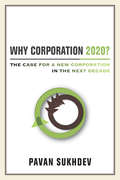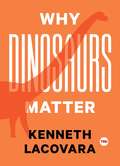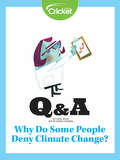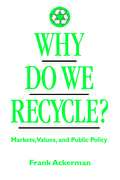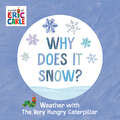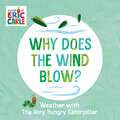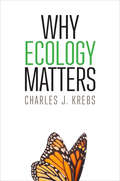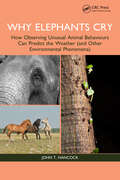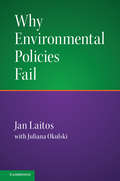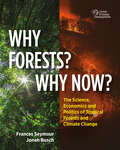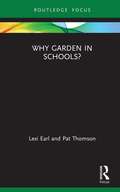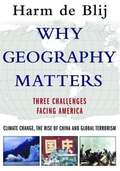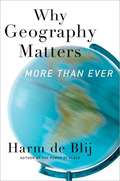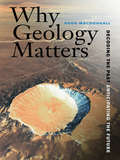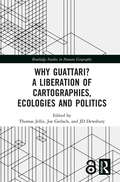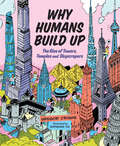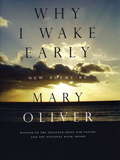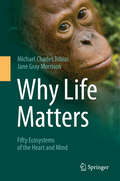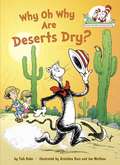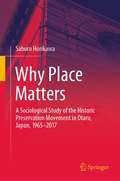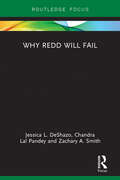- Table View
- List View
Why Corporation 2020?: The Case for a New Corporation in the Next Decade
by Pavan SukhdevIn Why Corporation 2020?, Pavan Sukhdev examines the many critical planetary boundaries that we are approaching, from greenhouse gas emissions to the nitrogen cycle, freshwater and land use, and food security, and argues that sweeping changes are needed to reform the way we deal with the earth's resources. Sukhdev makes an arresting case for including the private sector in these changes, arguing that a new corporate model is needed in the next decade to avert irreparable ecological harm.
Why Dinosaurs Matter (TED Books)
by Kenneth LacovaraWhat can long-dead dinosaurs teach us about our future? Plenty, according to paleontologist Kenneth Lacovara, who has discovered some of the largest creatures to ever walk the Earth.By tapping into the ubiquitous wonder that dinosaurs inspire, Lacovara weaves together the stories of our geological awakening, of humanity&’s epic struggle to understand the nature of deep time, the meaning of fossils, and our own place on the vast and bountiful tree of life. Go on a journey––back to when dinosaurs ruled the Earth––to discover how dinosaurs achieved feats unparalleled by any other group of animals. Learn the secrets of how paleontologists find fossils, and explore quirky, but profound questions, such as: Is a penguin a dinosaur? And, how are the tiny arms of T. rex the key to its power and ferocity? In this revealing book, Lacovara offers the latest ideas about the shocking and calamitous death of the dinosaurs and ties their vulnerabilities to our own. Why Dinosaurs Matter is compelling and engaging—a great reminder that our place on this planet is both precarious and potentially fleeting. &“As we move into an uncertain environmental future, it has never been more important to understand the past.&”
Why Do Elephants Need the Sun?
by Robert E WellsThere are trillions of stars in the universe, but we rely on our sun to provide (or contribute to) most of what we need to survive and thrive: heat, light, plants, animals, wind, and water. Complete with fun, cartoon illustrations, Robert Wells's new book gives kids plenty of information about our sun in an easy-to-read-and-digest format. By focusing on the needs of an elephant, Wells makes clear just how important the sun is to life on Earth.
Why Do Leaves Change Color? (Let's-Read-and-Find-Out Science 2)
by Betsy MaestroRead and find out about the magical process of how leaves change their color in this colorfully illustrated nonfiction picture book.This book includes simple, fun diagrams that help introduce concepts like photosynthesis and the different types of leaves. This book also includes a list of the best spots to view leaves changing color as well as simple activities to do with leaves, like leaf rubbings and leaf pressings.Questions addressed in this book include:How do leaves feed trees?What kind of weather brings out the best colors?Why is winter a time of rest for trees?Read and find out in the proven winner Why Do Leaves Change Color?This is a Level 2 Let's-Read-and-Find-Out, which means the book explores more challenging concepts for children in the primary grades. The 100+ titles in this leading nonfiction series are:hands-on and visualacclaimed and trustedgreat for classroomsTop 10 reasons to love LRFOs:Entertain and educate at the same timeHave appealing, child-centered topicsDevelopmentally appropriate for emerging readersFocused; answering questions instead of using survey approachEmploy engaging picture book quality illustrationsUse simple charts and graphics to improve visual literacy skillsFeature hands-on activities to engage young scientistsMeet national science education standardsWritten/illustrated by award-winning authors/illustrators & vetted by an expert in the fieldOver 130 titles in print, meeting a wide range of kids' scientific interestsBooks in this series support the Common Core Learning Standards, Next Generation Science Standards, and the Science, Technology, Engineering, and Math (STEM) standards. Let's-Read-and-Find-Out is the winner of the American Association for the Advancement of Science/Subaru Science Books & Films Prize for Outstanding Science Series.
Why Do Some People Deny Climate Change?
by Lizzie WadeDespite a mountain of evidence, some people still don't believe that climate change is occurring. Why is that? Find out in this insightful Q & A.
Why Do We Recycle?: Markets, Values, and Public Policy
by Frank AckermanThe earnest warnings of an impending "solid waste crisis" that permeated the 1980s provided the impetus for the widespread adoption of municipal recycling programs, and since that time America has witnessed a remarkable rise in public participation in recycling activities. Recently, however, a backlash against these programs has developed. A vocal group of "anti-recyclers" has appeared, arguing that recycling is not an economically efficient strategy for addressing waste management problems. In Why Do We Recycle? Frank Ackerman examines the arguments for and against recycling, focusing on the debate surrounding the use of economic mechanisms to determine the value of recycling. Based on previously unpublished research, Ackerman presents an alternative view of the theory of market incentives, challenging the notion that setting appropriate prices and allowing unfettered competition will result in the most efficient level of recycling. Among the topics he considers are: externality issues, the landfill crisis and disposal facility siting, container deposit legislation, environmental issues that fall outside of market theory, costs and benefits of municipal recycling programs, life-cycle analysis and packaging policy, the impacts of production in extractive and manufacturing industries, composting and organic waste management, economics of conservation, and material use and long-term sustainability. Ackerman explains why purely economic approaches to recycling are incomplete and argues for a different kind of decisionmaking, one that addresses social issues, future as well as present resource needs, and non-economic values that cannot be translated into dollars and cents. Backed by empirical data and replete with specific examples, the book offers valuable guidance for planners and policymakers as well as an accessible introduction to the subject for students and citizens interested in the social, economic, and ethical underpinnings of recycling efforts.
Why Does It Snow?: Weather with The Very Hungry Caterpillar
by Eric CarleLearn why it snows with the help of The Very Hungry Caterpillar!In this nonfiction story, young readers will discover what makes snow fall. The wonders of nature come to life in this early-learning series centered around weather, featuring simple text and Eric Carle's classic illustrations!
Why Does the Wind Blow?: Weather with The Very Hungry Caterpillar
by Eric CarleLearn why the wind blows with the help of The Very Hungry Caterpillar!In this nonfiction story, young readers will discover what makes the wind whoosh around them. The wonders of nature come to life in this early-learning series centered around weather, featuring simple text and Eric Carle's classic illustrations!
Why Ecology Matters
by Charles J. KrebsGlobal temperatures and seawater levels rise; the world’s smallest porpoise species looms at the edge of extinction; and a tiny emerald beetle from Japan flourishes in North America—but why does it matter? Who cares? With this concise, accessible, and up-to-date book, Charles J. Krebs answers critics and enlightens students and environmental advocates alike, revealing not why phenomena like these deserve our attention, but why they demand it. Highlighting key principles in ecology—from species extinction to the sun’s role in powering ecosystems—each chapter introduces a general question, illustrates that question with real-world examples, and links it to pressing ecological issues in which humans play a central role, such as the spread of invasive species, climate change, overfishing, and biodiversity conservation. While other introductions to ecology are rooted in complex theory, math, or practice and relegate discussions of human environmental impacts and their societal implications to sidebars and appendices, Why Ecology Matters interweaves these important discussions throughout. It is a book rooted in our contemporary world, delving into ecological issues that are perennial, timeless, but could not be more timely.
Why Elephants Cry: How Observing Unusual Animal Behaviours Can Predict the Weather (and Other Environmental Phenomena)
by John T. HancockWhy Elephants Cry is a fascinating frolic through the literature and evidence surrounding the use of unusual behavior of animals to measure and predict the environment. The role of animals, from the smallest ant to the biggest elephant, as predictors of environmental changes is framed around the climate crisis, which highlights the increasingly important part that animals will have to play in the future. Renowned biologist Professor John T. Hancock collects anecdotal stories and myths along with scientific evidence, demonstrating that observation of animals can be of tangible use. He looks at the measurement of the air temperature using ants, crickets and snakes, and goes on to assess the evidence that the observation of a wide range of animals can predict the weather or the imminent eruption of volcanoes and earthquakes. Evidence of animals being able to predict lunar and solar events, such as lunar cycles and the Northern Lights, is also considered. This is the only time that all this literature has been brought together in one place, a fascinating reference for anybody interested in animals and the environment. The book is also an ideal supplementary textbook for students studying animal behaviour.
Why Environmental Policies Fail
by Jan Laitos Juliana OkulskiThis book is for those who are not just interested in the ways humans have harmfully altered their environment, but instead wish to learn why the many governmental policies in place to curb such behavior have been unsuccessful. Since humans began to exploit natural resources for their own economic ends, we have ignored a central principle: nature and humans are not separate, but are a unified, interconnected system in which neither is superior to the other. Policy must reflect this reality. We failed to follow this principle in exploiting natural capital without expecting to pay any price, and in hurriedly adopting environmental laws and policies that reflected how we wanted nature to work instead of how it does work. This study relies on more accurate models for how nature works and humans behave. These models suggest that environmental laws should be consistent with the laws of nature.
Why Forests? Why Now?: The Science, Economics, and Politics of Tropical Forests and Climate Change
by Frances Seymour Jonah BuschTropical forests are an undervalued asset in meeting the greatest global challenges of our time-averting climate change and promoting development. Despite their importance, tropical forests and their ecosystems are being destroyed at a high and even increasing rate in most forest-rich countries. The good news is that the science, economics, and politics are aligned to support a major international effort over the next five years to reverse tropical deforestation. Why Forests? Why Now? synthesizes the latest evidence on the importance of tropical forests in a way that is accessible to anyone interested in climate change and development and to readers already familiar with the problem of deforestation. It makes the case to decisionmakers in rich countries that rewarding developing countries for protecting their forests is urgent, affordable, and achievable.
Why Frogs Are Wet (Let's-Read-and-Find-Out Science 2)
by Judy HawesRead and find out about frogs in this colorfully illustrated nonfiction picture book.Frogs can jump thirty times their own body length, catch insects on the wing, and breathe underwater or on land. But they must always keep their skins wet. Read and find out why! This is a clear and appealing science book for early elementary age kids, both at home and in the classroom. It's a Level 2 Let's-Read-and-Find-Out, which means the book explores more challenging concepts for children in the primary grades. The 100+ titles in this leading nonfiction series are:hands-on and visualacclaimed and trustedgreat for classroomsTop 10 reasons to love LRFOs:Entertain and educate at the same timeHave appealing, child-centered topicsDevelopmentally appropriate for emerging readersFocused; answering questions instead of using survey approachEmploy engaging picture book quality illustrationsUse simple charts and graphics to improve visual literacy skillsFeature hands-on activities to engage young scientistsMeet national science education standardsWritten/illustrated by award-winning authors/illustrators & vetted by an expert in the fieldOver 130 titles in print, meeting a wide range of kids' scientific interestsBooks in this series support the Common Core Learning Standards, Next Generation Science Standards, and the Science, Technology, Engineering, and Math (STEM) standards. Let's-Read-and-Find-Out is the winner of the American Association for the Advancement of Science/Subaru Science Books & Films Prize for Outstanding Science Series.
Why Garden in Schools? (Routledge Spaces of Childhood and Youth Series)
by Pat Thomson Lexi EarlThis book delves into the complex history of the gardening movement in schools and examines the question why gardens should be built in schools. It offers practical guidance for teachers to begin thinking about how to approach educational gardening. A resurgence of interest in school gardens is linked to concerns about children’s health, food knowledge, lack of outdoor play and contact with the natural world. This book warns against simplistic one-best approaches and makes a case about the complexity of gardening in schools. It is the first critical attempt to address the complex and conflicting notions about school gardens and to tackle the question ‘what is the problem to which school gardens are the answer?’ Examining the educational theory in which gardening has been explained and advocated, the book explores the way contemporary gardens research has been conducted with specific questions such as ‘what works well in school gardens?’ Based on case studies of a school establishing a garden and another one maintaining a garden, chapters look at the way in which schools come to frame their gardens. The authors suggest that there are four issues to consider when setting up a school garden or evaluating a pre-existing one – wider social context, public policy, the whole school, and the formal and informal curriculum. The book ends with a call for consideration of the ways in which school gardens can be built, the myriad practices that constitute an educational garden space and the challenges of maintaining a school garden over the long term. It will be of interest to teachers in primary schools, as well as a key point of reference for scholars, academics and students researching school gardens.
Why Geography Matters: Climate Change, The Rise of China, and Global Terrorism
by Harm De BlijDe Blij, a geography professor and former National Geographic Society editor, seeks to rekindle interest in his discipline with this unfocused survey of the world and its discontents. Struggling to describe his notoriously hard-to-define field, de Blij suggests that geographers "look at things spatially" as opposed to "temporally" or "structurally," the "things" being a grab bag of phenomena, including climate, topography, demographics, national boundaries and the distribution of languages, religions, energy deposits and pipelines.
Why Geography Matters: More Than Ever
by Harm De BlijFor anyone trying to understand our complex and dynamic world, this book offers not only a unique trove of concepts and ideas, but links them clearly and directly to world events.
Why Geology Matters: Decoding the Past, Anticipating the Future
by Doug MacdougallVolcanic dust, climate change, tsunamis, earthquakes--geoscience explores phenomena that profoundly affect our lives. But more than that, as Doug Macdougall makes clear, the science also provides important clues to the future of the planet. In an entertaining and accessibly written narrative, Macdougall gives an overview of Earth's astonishing history based on information extracted from rocks, ice cores, and other natural archives. He explores such questions as: What is the risk of an asteroid striking Earth? Why does the temperature of the ocean millions of years ago matter today? How are efforts to predict earthquakes progressing? Macdougall also explains the legacy of greenhouse gases from Earth's past and shows how that legacy shapes our understanding of today's human-caused climate change. We find that geoscience in fact illuminates many of today's most pressing issues--the availability of energy, access to fresh water, sustainable agriculture, maintaining biodiversity--and we discover how, by applying new technologies and ideas, we can use it to prepare for the future.
Why Greenland Is an Island, Australia Is Not, and Japan Is Up for Grabs
by Joyce DavisFrom the book: Any geographer will tell you that a map is but one of many tools used in the field, yet every geography book on the market tries to teach geography simply by having you identify Belize on a map or memorize the capital of Idaho. While the where is important, it is useful only for trivial reasons, and once national boundaries change or disappear, such as we've recently seen in the former Yugoslavia, the information is all but useless. In Why Greenland Is an Island, Australia Is Not-and Japan Is Up for Grabs, Joyce Davis tells you the why behind the where, offering one of the most interesting and useful books on geography currently found on the market. In Why Greenland Is an Island you will discover a clear method of approaching any geographical dilemma you might face. Through six simple steps Joyce Davis shows not only how to gather geographical information about any region, but also how to understand other aspects of the region seemingly not related to geography. You will also gain a solid background in basic geography skills, and will even touch base on what the capital of Idaho is and learn how to read a map. If you're tired of geography books that leave you feeling more helpless than when you first opened them, then it's time to get your bearings and read Joyce Davis's Why Greenland Is an Island now. Joyce Davis is a teacher of geography and former head of the history and geography departments at the Grace Church School in New York City. An originator of the geographic curriculum there and founder of the school's annual "geography bee," she currently lives 74 degrees west longitude and 40.5 degrees north latitude, also known as New York City.
Why Guattari? A Liberation of Cartographies, Ecologies and Politics: A Liberation Of Cartographies, Ecologies And Politics (Routledge Studies in Human Geography)
by Thomas Jellis Joe Gerlach John-David DewsburyThis book examines Félix Guattari, the French psychoanalyst, philosopher, and radical activist, renowned for an energetic style of thought that cuts across conceptual, political, and institutional spheres. Increasingly recognised as a key figure in his own right, Guattari’s influence in contemporary social theory and the modern social sciences continues to grow. From the ecosophy of hurricanes to the micropolitics of cinema, the book draws together a series of Guattarian motifs which animate the complexity of one of the twentieth century’s greatest and most enigmatic thinkers. The book examines techniques and modes of thought that contribute to a liberation of thinking and subjectivity. Divided thematically into three parts – ‘cartographies’, ‘ecologies’, and ‘micropolitics’ – each chapter showcases the singular and pragmatic grounds by which Guattari’s signature concepts can be found to be both disruptive to traditional modes of thinking, and generative toward novel forms of ethics, politics and sociality. This interdisciplinary compendium on Guattari’s exciting, experimental, and enigmatic thought will appeal to academics and postgraduates within Social Theory, Human Geography, and Continental Philosophy. Chapter 1 of this book is freely available as a downloadable Open Access PDF at http://www.taylorfrancis.com under a Creative Commons Attribution-Non Commercial-No Derivatives (CC-BY-NC-ND) 4.0 license.
Why Humans Build Up: The Rise of Towers, Temples and Skyscrapers (Orca Timeline #1)
by Gregor Craigie★“This great STEAM offering has multiple applications and will be useful for report writers and aspiring architects alike.”—Booklist, starred review ★“Finely detailed inside and outside...Broad in scope, perceptively organized, and enriched with fascinating entries.”—Kirkus Reviews, starred review Why did they build it so high? People have been constructing tall buildings for thousands of years, for many different reasons. Castle walls kept people safe. Utility towers transmit TV and cell-phone signals. Observatories give people a bird’s-eye view of the world. Beautiful buildings stand out in the crowd. Skyscrapers provide housing for a lot of people. There are some good reasons for building up, and a few bad ones as well. With a growing global population, we will need more and more space to live, learn and work in. But what does that mean for the health of the planet? Can we do it sustainably? Tall buildings may be part of the answer. From the Great Pyramids of Giza and the Leaning Tower of Pisa to the Burj Khalifa and the Shanghai Tower, Why Humans Build Up asks why and how we build higher and higher, and what that means for the planet.
Why I Wake Early
by Mary OliverThe forty-seven new works in this volume include poems on crickets, toads, trout lilies, black snakes, goldenrod, bears, greeting the morning, watching the deer, and, finally, lingering in happiness. Each poem is imbued with the extraordinary perceptions of a poet who considers the everyday in our lives and the natural world around us and finds a multitude of reasons to wake early.
Why Life Matters
by Michael Charles Tobias Jane Gray MorrisonDr. Michael Charles Tobias and Jane Gray Morrison are world-renowned ecological philosophers and activists, interdisciplinary social and environmental scientists and broad-ranging, deeply committed humanists. This collection of fifty essays and interviews comprises an invigorating, outspoken, provocative and eloquent overview of the ecological humanities in one highly accessible volume. The components of this collection were published in the authors' "Green Conversations" blog series, and pieces in the Eco News Network from 2011 to 2013 and feature luminaries from Jane Goodall to Ted Turner to the Secretary of the Smithsonian Institution to the former head of the UN Convention on Biological Diversity. Stunning color photographs captured by the authors and contributors make Why Life Matters: Fifty Ecosystems of the Heart and Mind a feast for the eyes as well as the mind and soul. Ethics, science, technology, ecological literacy, grass-roots renaissance thinkers, conservation innovation from the U. S. to the U. K. ; from India to Ecuador; from Bhutan to Haiti; from across Africa, the Neo-Tropics, Central Asia and Japan, to Rio, Shanghai and Manhattan - this humanistic ode to the future of life on earth is a relevant and resonating read. Michael Tobias and Jane Gray Morrison, partners who between them have authored some 50 books and written, directed and produced some 170 films, a prolific body of work that has been read, translated and/or broadcast around the world, have been married for more than a quarter-of-a-century. Their field research across the disciplines of comparative literature, anthropology, the history of science and philosophy, ecology and ethics, in over 80 countries, has served as a telling example of what two people - deeply in love with one another - can accomplish in spreading that same unconditional love to others - of all species.
Why Oh Why Are Deserts Dry? All About Deserts
by Joe Mathieu Aristides Ruiz Tish RabeIn this latest installation of the Cat in the Hat's Learning Library, the Cat takes Sally and Dick to explore different kinds of deserts around the world, from the hot, dry Sonoran and Mojavi to the bitter cold Gobi and Antarctica. Young readers learn why deserts are dry, and how plants and animals--including cactus, kangaroos, camels, penguins, roadrunners, and many others--have adapted to survive the unforgiving climate. Also included: how sand dunes are formed; the reason we see mirages, and how shallow water beneath the surface of the ground can create an oasis. Fans of the new PBS preschool science show The Cat in the Hat Knows a Lot About That! (which is based on the Learning Library series) won't want to miss this hot new addition to the series!
Why Place Matters: A Sociological Study of the Historic Preservation Movement in Otaru, Japan, 1965–2017
by Saburo HorikawaThis book is based on the author’s 33 years of intensive fieldwork. It chronicles a major movement that shaped the preservation policy in Japan in the 1980s and 1990s, providing “thick descriptions” of preservationists that are not available anywhere else in English. It also provides clear answers to a series of pressing questions about preservationists: are they building-huggers, are they selfish and myopic home-owners, or are they merely obstacles to urban planning and urban renewal? Since 1984, Saburo Horikawa, Professor of Sociology at Hosei University in Tokyo, has continuously studied the movement to preserve the Otaru Canal in Otaru, Japan. This book shows that the preservation movement was neither conservative nor an obstacle. Rather, the movement sought to promote changes in which the residents’ “place” would continue to be theirs. As such, the word “preservation” does not mean the prevention of growth and development, but rather its control. As is shown in this study, preservation allows for and can even promote change. The original Japanese version of this book (published by the University of Tokyo Press) has won 3 major academic awards; most notably, “The Ishikawa Prize”, the highest award bestowed by the City Planning Institute of Japan. It is extremely unusual that a sociology book should receive such important recognition from the city planning discipline.
Why REDD will Fail (Routledge Studies in Environmental Policy)
by Zachary A. Smith Chandra Lal Pandey Jessica L. DeShazoReducing Emissions from Deforestation and forest Degradation (REDD) attempts to address climate change from one angle – by paying developing countries to slow or stop deforestation and forest degradation. Trumpeted as a way to both mitigate climate change and assist countries with development, REDD was presented as a win-win solution. However, there have been few attempts to understand and analyse the overall framework. Why REDD Will Fail argues that the important goals will not be met under the existing REDD regime unless the actual drivers of deforestation and forest degradation are diminished. The book delves into the problematic details of the regime, ranging from; national capacity to monitor results, the funding mechanism, the definition of a forest, leakage, and the impetus behind the drivers of deforestation and forest degradation. As the international community rallies around REDD and developed countries and companies are willing to commit substantial amounts to implement the scheme, this books seeks to address whether REDD has the potential to achieve its purported goals. This is an important resource for academics and students interested in the policy and management aspects of mitigating climate change, environmental policy, international relations and development studies as well as policy makers involved in the REDD process.
